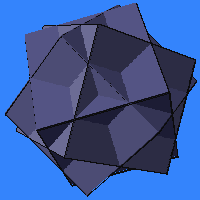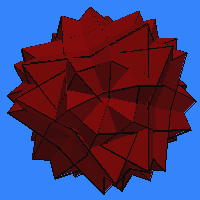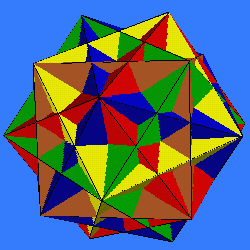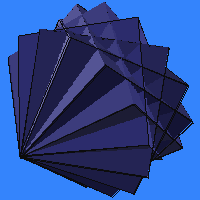Compounds of Cubes
 There
are many ways to assemble identical concentric cubes into a compound
with overall polyhedral symmetry. This page illustrates the basic ideas
with a few examples. We construct compounds by imagining the symmetry
axes of the desired compound and arranging component cubes to have
their symmetry axes arranged appropriately relative to the compound. The
"standard" uniform compound of five cubes
is a very special case, with icosahedral symmetry. Shown at left is the
elegant uniform compound of three cubes
which has octahedral symmetry, as discussed below.
There
are many ways to assemble identical concentric cubes into a compound
with overall polyhedral symmetry. This page illustrates the basic ideas
with a few examples. We construct compounds by imagining the symmetry
axes of the desired compound and arranging component cubes to have
their symmetry axes arranged appropriately relative to the compound. The
"standard" uniform compound of five cubes
is a very special case, with icosahedral symmetry. Shown at left is the
elegant uniform compound of three cubes
which has octahedral symmetry, as discussed below.
Besides being interesting exercises in visualization and symmetry, these are fun examples for switching your mind back and forth between seeing the whole and seeing the parts. Each one also presents an individual challenge for you to imagine the shape of its interior before going in to look.
The compounds of cubes on this page and the mathematical relations between them are detailed in the book Symmetry Orbits by Hugo F. Verhayen, listed in the references. It also contains photos of intricate paper models of many of these models, made by Magnus Wenninger or Verheyen. For more compounds (including their duals --- compounds of octahedra which that book does not discuss) see my big list of cube and octahedra compounds. Many of these are derived by Harman's method. Four of the cube compounds on this page and several of the octahedral compounds are uniform; that notion is defined on a separate page about the uniform compounds of uniform polyhedra.
Prism Symmetry:
The standard compound of five cubes is not the only compound of five cubes. Here are some interesting compounds of five cubes arranged so that the overall compound has prism symmetry:- five cubes with a common 4-fold axis (this looks like a 20-toothed gear; the result is uniform, being a 20/5 prism with 20-fold symmetry; the edges lie in two planes and a cylinder)
- five cubes with a common 3-fold axis (the edges of the cubes define two cones and a hyperboloid; the result has 15-fold symmetry)
- five cubes with a common 2-fold axis (the edges lie in three planes and two hyperboloids; the result has 10-fold symmetry)
- five cubes with a 2-fold axis of the cube being a 2-fold axis of the compound (the result has 5-fold symmetry)
- five cubes with a 4-fold axis of the cube being a 2-fold axis of the compound (the result has 5-fold symmetry)
The next-to-last compound in the above list is analogous to the last, but the five axes are chosen to go through two opposite edge midpoints (rather than the face centers) of the five cubes in the "gear," before rotating the cubes on the axes [*].
In these compounds with prism symmetry, there is nothing special about the number five, and we could make similar compounds of any number of cubes. For example here is a compound of two cubes with a common 3-fold axis, resulting in 6-fold symmetry.
Octahedral Symmetry:
 It
is also possible to construct compounds which have the same symmetry as
the cube itself (i.e., the symmetry of the octahedron). The following three
cases are rigid; for each, find the compound's three 4-fold axes, four
3-fold axes, and six 2-fold axes. Each can be visualized by starting with
multiple superimposed copies of a single cube, and rotating each copy the
same angle about a different axis.
It
is also possible to construct compounds which have the same symmetry as
the cube itself (i.e., the symmetry of the octahedron). The following three
cases are rigid; for each, find the compound's three 4-fold axes, four
3-fold axes, and six 2-fold axes. Each can be visualized by starting with
multiple superimposed copies of a single cube, and rotating each copy the
same angle about a different axis.
- the compound of three cubes. Pictured at the top of the page, this uniform compound can be obtained by rotating three overlapping copies of a cube each 45 degrees about one of the three 4-fold axes. This is a relatively well known compound, appearing e.g., in the 1900 book by Bruckner listed in the references and in a famous lithograph by M.C Escher.)
- the compound of four cubes. Shown at right, this is obtained by rotating four overlapping copies of a cube, each 60 degrees about one of the four 3-fold axes. This was apparently first described in a 1959 paper by T. Bakos and is sometimes referred to as Bakos' compound.)
- the compound of six cubes. Rotate six overlapping copies of a cube, each 90 degrees about one of the six 2-fold axes. As a result, each 2-fold axis of the compound also has one 4-fold axis of one of the cubes aligned with it. This is one of many compounds first described in the unpublished 1974 paper by M. Harman.)
- three octahedra (also appearing in Bruckner's 1900 book, M.C. Escher made great use of this one as well.)
- four octahedra (this one is notable because it is uniform)
- six octahedra
Another technique used in creating compounds is called splitting, meaning that pairs of cubes are counter-rotated along the desired symmetry axes: First, imagine six cubes, initially overlapping exactly on top of each other. Imagine also two copies of each of their three 4-fold symmetry axes---a total of six axes. Now attach each one of these six cubes to one of these six axes. Finally, rotate each axis through the same angle, but in each pair of axes, turn one clockwise and one counterclockwise. The result will be a compound of six cubes with a degree of rotational freedom, called Skilling's compound [*], being one of the uniform compounds first described in the 1976 paper by J. Skilling. Here is the same compound but with a different rotation angle. Note that with a rotation angle of 45 degrees, pairs of cubes would overlap and the compound would reduce to the compound of three cubes discussed above.
 Splitting
four cubes along the four 3-fold axes gives this compound
of eight cubes [*], which is
of interest because its dual is the uniform
compound of eight octahedra [*].
And splitting six cubes along the six 2-fold axes gives this compound
of twelve cubes [*]. Because
a 4-fold axis is also a 2-fold axis (and then some), we can place six cubes
each with a 4-fold axis along the directions of the compound's 2-fold axes
to make the above compound of 6 cubes,
and then split them to make this compound
of 12 cubes [*].
Splitting
four cubes along the four 3-fold axes gives this compound
of eight cubes [*], which is
of interest because its dual is the uniform
compound of eight octahedra [*].
And splitting six cubes along the six 2-fold axes gives this compound
of twelve cubes [*]. Because
a 4-fold axis is also a 2-fold axis (and then some), we can place six cubes
each with a 4-fold axis along the directions of the compound's 2-fold axes
to make the above compound of 6 cubes,
and then split them to make this compound
of 12 cubes [*].
Here is a kind of double splitting: We place the 2-fold axis of two cubes along the 4-fold axis of the desired compound; these two cubes are turned relative to each other by 90 degrees to give a sub-compound with 4-fold symmetry along that axis. Splitting these pairs to four cubes along each of the three 4-fold axes gives a compound of twelve cubes. Varying the free rotation angle causes this to unfold like a flower. Here are five progressively larger angles: 1, 2, 3, 4, 5.
Icosahedral Symmetry:
 The
standard compound of five cubes is noteworthy
for creating so much symmetry out of just five pieces. It makes optimal
use of the tetrahedral symmetry within the cube to construct an object
with icosahedral symmetry. Many other compounds are possible with icosahedral
symmetry, but a larger number of cubes is needed.
The
standard compound of five cubes is noteworthy
for creating so much symmetry out of just five pieces. It makes optimal
use of the tetrahedral symmetry within the cube to construct an object
with icosahedral symmetry. Many other compounds are possible with icosahedral
symmetry, but a larger number of cubes is needed.
There are two remarkable rigid compounds of ten cubes. To understand them, recall first from your knowledge of platonic relationships how one inscribes a cube in a dodecahedron so that eight of the vertices of the dodecahedron are vertices of the cube. That is the orientation of each cube in the above compound of five cubes. If instead we rotate the cube along one of the 3-fold axes common to it and the dodecahedron, there are two other angles of geometric importance: three edges of the cube (which are still in contact with a dodecahedron vertex) can point to intersect either three nearby 3-fold axes of the dodecahedron or three nearby 5-fold axes. Choosing either of these angles and putting one such cube along each of the ten 3-fold axes of the dodecahedron gives us two different compounds of ten cubes. First described in Harman's 1974 paper, they are called version A and version B, respectively. Dual to these two compounds of ten cubes are two uniform compounds of ten octahedra: version A, version B.
By splitting the ten cubes, starting from either version, we get a compound of 20 cubes with rotational freedom. Here are three different angles: 1, 2, 3. The respective duals to these are uniform compounds of twenty octahedra: 1, 2, 3. The first of these three angles is special in that the cubes' face planes align into 60 coplanar pairs, so the octahedra vertices coincide in pairs, resulting in a rigid compound of 20 octahedra.
By aligning a 2-fold axis of a cube with each of the fifteen 2-fold axes of the icosahedron, we obtain a rigid compound of fifteen cubes. (The cube edge can be made parallel or perpendicular to the icosahedron edge; either way the result is the same.) Splitting this gives a compound of 30 cubes with rotational freedom; here are five different angles: 1, 2, 3, 4, 5.
Tetrahedral Symmetry:
Finally, we mention two compounds of cubes with tetrahedral symmetry.The first is a nonrigid compound of six cubes [*], constructed by aligning the 2-fold axis of a cube with each of the three 2-fold axes of the tetrahedron and using the splitting technique described above.
The second is rather interesting in that it is constructed by aligning four overlapping cubes so they each have a 3-fold axis in the direction of one of the tetrahedron's four 3-fold axes. Although these are the same directions as the original cube's four 3-fold axes, you must think of them as the tetrahedron's axes for the following step to make sense: Choose an angle and turn each cube on its axis by that angle clockwise as seen from a tetrahedron vertex. This will be counterclockwise as seen from a tetrahedron face at the other end of the axis. The result is a nonrigid compound of four cubes [*]. Find its 3-fold axes and see how every other one has the opposite handedness. At an angle of 60 degrees, it becomes the rigid Bakos compound listed above, with octahedral symmetry. At another angle, this becomes a compound of 4 of the 5 cubes from the standard icosahedral compound of 5 cubes. (The missing one from the five is the original unrotated cube. If we were to also include the original cube unrotated, to make a "compound compound" as described in the next section, the result would be the standard icosahedral compound of 5 cubes.)
Dual to this is the uniform nonrigid compound of 4 octahedra [*]. At the 60 degree angle it reduces to the uniform compound of four octahedra, and at the other angle, a compound of 4 of the 5 octahedra from the standard icosahedral compound of 5 octahedra.
Compound compounds:
One can superimpose different compounds with the same symmetry to obtain more complex compounds with that same symmetry, but the result is not entirely symmetric in the following sense. In all the above compounds, every cube (or octahedron) is in the same relationship to the overall compound and no two cubes are distinguishable. There is always some transformation (rotation or reflection) which moves any given cube to the position of any other given cube while leaving the appearance of the overall compound unchanged. However, in compound compounds, such as the following four examples, this property does not hold. Instead, one can distinguish the cubes in one subcompound from the cubes in another.Superimposing the two rigid compounds of ten cubes (version A and version B) gives a rigid compound of 20 cubes with icosahedral symmetry.
Combining Bakos' compound of four cubes with one cube from which it is derived gives a compound of five cubes which Verheyen calls the Theosophical compound, after a 1905 "Theosophical" paper in which it is described. In its dual, the extra octahedron seems out of place compared to the uniform compound of four octahedra.
Combining the uniform compound of three cubes with one cube from which it is derived gives a compound of four cubes. Its dual is described in the paper "Some Interesting Octahedral Compounds" by Wenninger, listed in the references.
As a final example, one may compound all the rigid compounds with octahedral symmetry---the compound of three cubes, the compound of four cubes, and the compound of six cubes, along with the original cube---to make a compound of fourteen cubes with octahedral symmetry.
Compound-mania:
- A complete list of these compounds of cubes and their dual compounds of octahedra.
- Uniform compounds.
- Harman's compounds.
- Spinning compounds.
* Footnote: Animated spinning versions of the compounds with rotational freedom are available by clicking the asterisks on this page.
